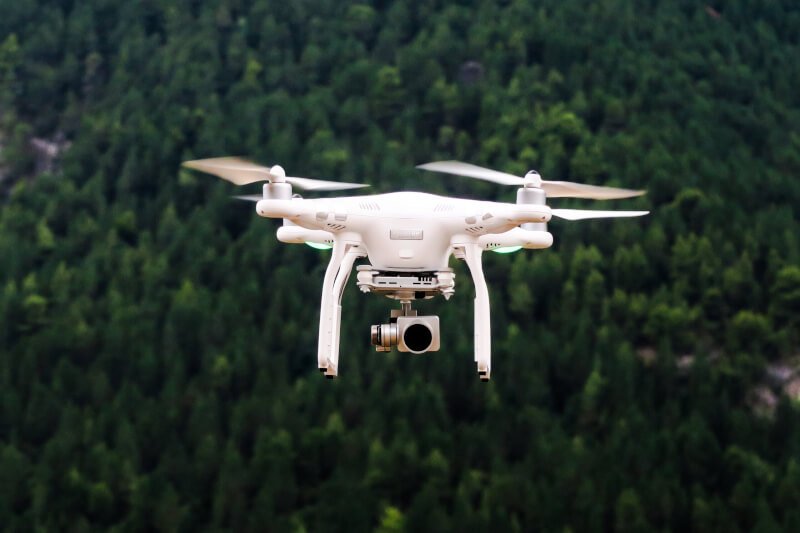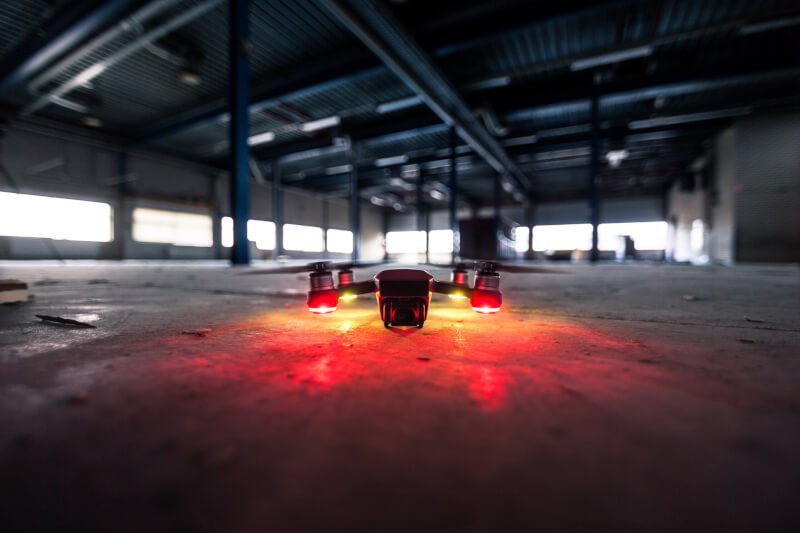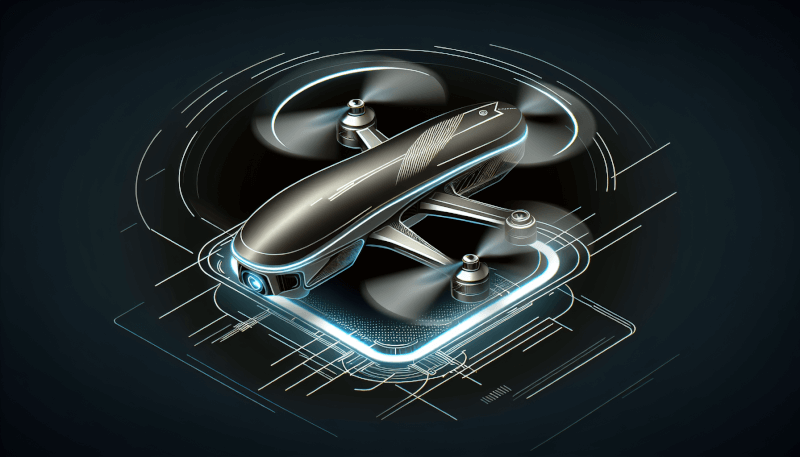Are you ready to take flight into the fascinating world of drone technology? In this article, we will explore the latest advancements in this rapidly evolving field. From enhanced flight capabilities to innovative sensors and cameras, drones are transforming industries and revolutionizing the way we capture aerial footage and gather data. So buckle up and prepare to be amazed by the cutting-edge advancements that are propelling drones to new heights.

1. Artificial Intelligence (AI) in Drones
Unleashing the power of Artificial Intelligence (AI) in drones has revolutionized the way these unmanned aerial vehicles operate. AI powers various aspects of drone technology, enhancing their capabilities and opening up a world of possibilities. Let’s explore some of the latest advancements in this field.
1.1 Computer Vision and Object Detection
Computer vision and object detection have become key components of modern drone technology. By leveraging AI algorithms, drones can now identify and track objects with remarkable precision. This advancement enables drones to perform tasks such as package delivery, search and rescue missions, and even wildlife monitoring. With AI-powered computer vision, drones can navigate complex environments and interact with their surroundings more effectively.
1.2 Autonomous Navigation and Flight Planning
Gone are the days when drones solely relied on manual control. Thanks to AI, drones can now navigate autonomously and plan their flight paths intelligently. By analyzing real-time data and utilizing machine learning algorithms, drones can make informed decisions about the best routes to take and the actions to perform. This autonomy allows drones to perform tasks more efficiently, whether it’s conducting aerial surveys, inspecting infrastructure, or capturing stunning aerial footage.
1.3 Swarm Intelligence
Swarm intelligence is another exciting advancement in drone technology. By applying AI principles, drones can now collaborate and operate as a swarm, working together towards a common goal. This enables them to perform complex tasks that would be challenging for a single drone to accomplish alone. Swarm intelligence has applications in various fields, including search and rescue operations, precision agriculture, and even entertainment displays. By leveraging AI, drones can achieve levels of coordination and efficiency that were previously unimaginable.
2. 5G Connectivity and Communication
The advent of 5G has brought about a new era of connectivity and communication for drones. With its low latency, high bandwidth, and greater coverage, 5G technology is set to revolutionize the capabilities of drones in numerous ways.
2.1 Low Latency and High Bandwidth
One of the key advantages that 5G brings to drones is low latency, meaning there is minimal delay in transmitting data between the drone and the ground control station. This allows for real-time communication and control, enabling applications that require immediate responsiveness, such as remote inspections and emergency response. Additionally, 5G offers high bandwidth, enabling drones to transmit large amounts of data quickly and efficiently. This is especially beneficial for tasks that involve high-resolution imaging, live streaming, and data-intensive operations.
2.2 Improved Real-Time Control
With 5G connectivity, drones can be controlled remotely and in real-time with unparalleled precision. This level of control opens up new possibilities for applications such as precision agriculture, where drones can be operated from a remote location and perform tasks with utmost accuracy. Real-time control also enhances the safety of drone operations, as operators can quickly respond to changing situations and navigate drones away from potential hazards.
2.3 Greater Range and Coverage
5G offers a significant improvement in the range and coverage of drone operations. With the ability to connect to a 5G network, drones can extend their range and cover larger areas without losing connectivity. This opens up opportunities for applications like long-range inspections, environmental monitoring, and even drone-based internet connectivity in remote areas. With 5G, the limitations of traditional wireless communication systems are overcome, enabling drones to operate in areas that were once out of reach.
3. Sense and Avoid Systems
Safety is a paramount concern in the world of drones, and advancements in sense and avoid systems have played a crucial role in mitigating potential risks and ensuring safe operations.
3.1 Collision Avoidance
AI-powered sense and avoid systems enable drones to detect and avoid obstacles in their flight path, greatly reducing the risk of collisions. Through the use of sensors, cameras, and sophisticated algorithms, drones can analyze their surroundings in real-time and take evasive actions when necessary. This technology has profound implications for applications such as aerial photography, package delivery, and infrastructure inspections, where drones need to navigate complex environments with precision and safety.
3.2 Enhanced Obstacle Detection
In addition to collision avoidance, modern drone technology incorporates enhanced obstacle detection capabilities. By utilizing AI algorithms and advanced sensors, drones can identify and classify various types of obstacles, including buildings, trees, and even moving objects. This level of detection enables drones to adapt their flight paths accordingly and avoid potential hazards in real-time. Enhanced obstacle detection is particularly useful when operating in challenging environments or conducting missions in densely populated areas.
3.3 Intelligent Path Planning
AI-powered path planning algorithms have transformed the way drones navigate and optimize their flight paths. By analyzing terrain data, weather conditions, and mission objectives, drones can autonomously plan the most efficient routes. This not only saves time and energy but also enables drones to reach their destinations more quickly and accurately. Intelligent path planning is crucial for applications such as delivery services, aerial inspections, and aerial surveys, where time and efficiency are of the essence.
4. Extended Flight Time and Battery Efficiency
One of the persistent challenges in drone technology has been limited flight time due to battery constraints. However, advancements in battery technologies and energy management systems have paved the way for extended flight time and improved battery efficiency.
4.1 Advanced Battery Technologies
Researchers and engineers have been actively working on developing advanced battery technologies specifically designed for drones. From higher energy density lithium-ion batteries to innovative fuel cells, these advancements have significantly increased the amount of power that drones can store and utilize. This translates into longer flight times, allowing drones to perform more extensive and time-sensitive tasks without needing frequent recharging.
4.2 Energy Harvesting Systems
Energy harvesting systems have emerged as a promising solution to overcome the limitations of conventional batteries. These systems allow drones to generate and store energy from their surroundings, reducing reliance on traditional power sources. Solar panels, wind turbines, and kinetic energy harvesting mechanisms are among the methods explored to harness renewable energy for prolonged flight durations. By combining energy harvesting with battery technologies, drones can achieve unprecedented flight times and perform missions that were previously impractical.
4.3 Efficient Power Management
Efficient power management is critical in enhancing drone flight time and battery efficiency. AI algorithms are increasingly being utilized to optimize power consumption, allowing drones to intelligently manage their energy usage during flight. From adjusting motor speeds to minimizing power-hungry operations, such as image processing, AI-powered power management systems enable drones to make informed decisions to maximize their flight time without compromising performance. This technology is particularly crucial for applications that require extended airborne operations, such as aerial surveillance and monitoring.

5. Hyperspectral Imaging and Sensor Fusion
Hyperspectral imaging and sensor fusion have become invaluable tools in the field of drone technology. These advancements enable drones to gather and process highly detailed data, facilitating a wide range of applications, particularly in environmental monitoring and precision agriculture.
5.1 Enhanced Data Collection and Analysis
Hyperspectral imaging involves capturing and analyzing data across numerous bands of the electromagnetic spectrum. By leveraging this technology, drones can gather detailed spectral information about the environment they are flying over. This data can be further analyzed to detect anomalies, monitor vegetation health, assess water quality, and even identify specific materials or substances. With AI algorithms, drones can process this vast amount of data with speed and accuracy, providing valuable insights for various industries.
5.2 Improved Environmental Monitoring
Drones equipped with hyperspectral imaging sensors and AI algorithms are revolutionizing environmental monitoring practices. From detecting pollutants and monitoring deforestation to tracking wildlife populations, drones offer a cost-effective and efficient solution for collecting high-resolution data over large areas. By analyzing the acquired data in real-time, drones can help scientists and researchers make informed decisions to protect and preserve the environment effectively.
5.3 Precision Agriculture Applications
Precision agriculture is an area where the combination of drone technology, hyperspectral imaging, and AI has immense potential. By capturing hyperspectral data, drones can assess crop health, identify nutrient deficiencies, and detect early signs of diseases or pests. This allows farmers to optimize their agricultural practices, improve crop yields, and reduce the use of pesticides and fertilizers. With AI-powered analytics, drones can provide farmers with detailed insights and recommendations, enabling them to make data-driven decisions for their operations.
6. Foldable and Portable Designs
Foldable and portable designs have become a popular trend in drone technology, offering convenience and flexibility for users. These designs cater to the needs of travelers, outdoor enthusiasts, and professionals alike, providing a compact and travel-friendly solution.
6.1 Compact and Travel-Friendly Drones
Foldable drones are designed to be easily folded and packed into a small form factor, making them highly portable and convenient for travel. These lightweight drones can be easily carried in backpacks or even pockets, allowing users to take them wherever they go. Whether capturing stunning aerial footage on a vacation or conducting aerial inspections during a remote expedition, compact and travel-friendly drones empower users to unleash their creativity and accomplish their objectives effortlessly.
6.2 Ease of Storage and Transportation
Traditional drones often come with bulky cases or storage requirements, but with foldable designs, this inconvenience is alleviated. Foldable drones can be neatly folded, reducing their size significantly and simplifying storage and transportation. This feature makes them ideal for individuals with limited storage space or those who frequently move their equipment, such as professional photographers, filmmakers, and surveyors. With foldable designs, drones can be stored compactly and easily transported from one location to another without compromising on performance or durability.
6.3 Quick Deployment and Set-Up
Foldable drones also offer the advantage of quick deployment and set-up. Users can unfold and assemble the drone within minutes, eliminating the need for complex assembly procedures. This feature is particularly beneficial for professionals who require rapid deployment for time-critical missions, emergency responders who need to act swiftly, or hobbyists who want to capture spontaneous moments. The ease and convenience of quick deployment make foldable drones a popular choice across various domains.

7. Smart and Adaptive Camera Technologies
Camera technologies have continuously evolved in tandem with drone advancements, leading to remarkable capabilities in capturing high-quality imagery and videos. Smart and adaptive camera technologies bring new possibilities and functionalities to drone photography and videography.
7.1 High-Resolution Imaging Capabilities
Drones equipped with AI-powered camera technologies can capture imagery and videos with exceptional clarity and resolution. High-resolution cameras enable professionals such as photographers, filmmakers, and surveyors to produce stunning visuals with intricate details. With the ability to capture images in RAW format, drones offer flexibility in post-processing, allowing photographers to unleash their creative vision and produce professional-grade results.
7.2 Active Tracking and Object Recognition
AI-powered active tracking and object recognition capabilities are transforming the way drones capture moving subjects. With advanced algorithms, drones can autonomously track and follow subjects in real-time, ensuring smooth footage and precise focus. This feature is particularly valuable for action sports enthusiasts, wildlife filmmakers, and event photographers looking to capture dynamic moments. By detecting and recognizing objects, drones can actively adapt their flight paths and camera angles to ensure the subject remains in the frame.
7.3 Real-Time Image Stabilization
Shaky footage is no longer a concern with real-time image stabilization technology. AI-powered stabilization algorithms detect and compensate for unwanted camera movements, ensuring smooth and steady videos even in challenging conditions. This technology is particularly valuable for aerial videography and inspection tasks that demand stable footage for analysis and documentation purposes. With real-time image stabilization, drones can deliver professional-grade results, rivaling traditional camera systems.
8. Safer and More Reliable Flight Controls
Enhancing the safety and reliability of drone flight controls has been a key focus in recent advancements. Redundant systems, improved navigation technologies, and advanced flight modes work together to ensure safer and more reliable drone operations.
8.1 Redundant Systems and Fail-safe Mechanisms
Redundancy plays a vital role in enhancing the reliability of drone flight controls. By incorporating duplicate systems such as sensors, motors, and communication modules, drones can continue to operate even in case of component failure. Fail-safe mechanisms ensure that the drone is equipped with emergency protocols, such as auto-landing or return-to-home functions, in critical situations. These measures reduce the risk of accidents, increase user confidence, and ensure the safety of both the drone and the surrounding environment.
8.2 Improved GPS and Navigation Systems
Accurate GPS and navigation systems are crucial for precise flight controls and reliable positioning. Modern drones leverage advanced GPS technology, often coupled with other positioning systems such as GLONASS or Galileo, to enhance their navigational capabilities. This enables drones to maintain stable flight patterns, follow specific routes, and perform autonomous tasks with minimal deviation. With improved navigation systems, drones can navigate complex environments more effectively and achieve precision in their operations.
8.3 Advanced Flight Modes
The introduction of advanced flight modes has expanded the capabilities and flexibility of drone operations. With features like waypoint navigation, orbit mode, and follow-me mode, drones can perform predefined flight paths or complex aerial maneuvers with ease. These flight modes enable users to capture unique perspectives, execute intricate cinematic shots, or focus on specific subjects dynamically. The availability of advanced flight modes empowers users to unlock their creativity and explore new dimensions in aerial photography and videography.

9. Rapid Drone Prototyping and 3D Printing
The development cycles of drone technologies have significantly accelerated through rapid prototyping and 3D printing. These techniques offer faster iterations, customizability, and cost-effective manufacturing processes.
9.1 Faster Development Cycles
Rapid prototyping enables drone manufacturers to iterate their designs quickly and efficiently. By utilizing 3D printing technology, designers can turn their concepts into physical prototypes with reduced time and cost compared to traditional manufacturing methods. This agility allows for faster design iterations, functional testing, and identification of areas for improvement. Rapid drone prototyping facilitates innovation and ensures that cutting-edge technologies can be brought to market rapidly.
9.2 Customizable and Lightweight Designs
3D printing enables customizability by freeing drone designs from the limitations of traditional manufacturing processes. With 3D printing, intricate and lightweight structures can be created, optimizing aerodynamics and reducing weight without compromising strength. Customizable designs also allow for the integration of specific components, sensors, or payloads, catering to the unique requirements of different industries. From specialized sensors for scientific research to lightweight frames for racing drones, 3D printing facilitates the creation of tailored solutions.
9.3 Cost-Effective Manufacturing Processes
The cost-effectiveness of 3D printing offers significant advantages in manufacturing drones. Traditional methods involve molds, tooling, and high-volume production to achieve economies of scale. However, 3D printing eliminates the need for expensive tooling, enabling cost-effective production even for low-volume batches or one-off designs. This economic advantage has democratized the drone industry, making it accessible to individuals, smaller companies, and enthusiasts who can now bring their ideas to life without substantial financial constraints.
10. Artificial Intelligence-Powered Analytics and Insights
Artificial Intelligence (AI) plays a significant role in analyzing drone data, extracting valuable insights, and enabling informed decision-making. AI-powered analytics revolutionize drone applications, providing unparalleled capabilities for data processing, real-time monitoring, predictive maintenance, and risk assessment.
10.1 Data Processing and Pattern Recognition
Drones generate vast amounts of data during their operations, including imagery, sensor readings, and telemetry information. AI-powered analytics processes this data efficiently, extracting relevant information and identifying patterns and trends. By automatically analyzing this wealth of data, drones can identify anomalies, detect changes over time, and extract meaningful insights for various industries. From infrastructure inspections to environmental monitoring, AI-powered data processing enables organizations to make informed decisions based on accurate and up-to-date information.
10.2 Real-Time Monitoring and Decision-Making
AI-powered analytics enables real-time monitoring of drone operations, allowing operators to acquire insights as events unfold. This capability is particularly valuable in time-critical scenarios, emergency response situations, or applications that require continuous monitoring, such as precision agriculture or security surveillance. By continuously analyzing and interpreting data in real-time, AI-powered systems can provide operators with actionable information and support timely decision-making, enhancing operational efficiency and safety.
10.3 Predictive Maintenance and Risk Assessment
AI-powered analytics can predict maintenance needs and assess risks in drone operations. By analyzing data from various sensors and historical performance data, AI algorithms can identify potential failures or components nearing the end of their lifecycle. This enables proactive maintenance planning and reduces the risk of unexpected downtime or accidents. Furthermore, AI algorithms can assess operational risks and provide recommendations to enhance safety and adherence to regulations. By harnessing the power of AI for predictive maintenance and risk assessment, organizations can optimize their drone fleet’s performance and minimize costly disruptions.
In conclusion, the advancements in drone technology have been nothing short of remarkable. Artificial Intelligence, 5G connectivity, sense and avoid systems, extended flight time, hyperspectral imaging, foldable designs, smart camera technologies, safer flight controls, rapid prototyping, and AI-powered analytics are revolutionizing the capabilities and applications of drones. With these advancements, drones are becoming invaluable tools across a wide range of industries, improving efficiency, providing new perspectives, and reaching places that were once inaccessible. As technology continues to evolve, the potential for drones to transform industries and society at large is limitless. So, get ready to explore and embrace the future of drone technology!



